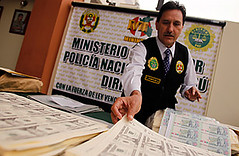
PREV ARTICLE
NEXT ARTICLE
FULL ISSUE
PREV FULL ISSUE
HOW PERU BECAME THE COUNTERFEIT-CASH CAPITAL OF THE WORLD
This TIME magazine article forwarded by an E-Sylum reader clearly shows why the Treasury department is so keen on introducing newer, stronger anti-counterfeiting features on U.S. currency.
-Editor
The printing presses have returned, but this time it is not the government cranking out bills, and the currency coming out is not necessarily the Peruvian nuevo sol. Some days it is euros, while others it is Venezuelan bolÍvares fuertes, or Bolivian and Chilean pesos. Most days, however, it is U.S. dollars. In the past two years, Peru has become the No. 1 distributor of counterfeit currency internationally, according to Kenneth Jenkins, a U.S. special agent in charge of the Secret Service's Criminal Investigative Division. "Approximately $33 million has been seized in Peru since 2009, which is a substantial number," Jenkins told TIME in a telephone interview from Washington. Officers in the Peruvian police's fraud unit estimate that a much larger sum of phony money is being printed in the country. They say that what has been seized in the past two years represents only a fraction of different bills, including Peruvian currency, being pumped out by clandestine printing presses. "Counterfeit operations have been multiplying for several years now. For every person we arrest, there are probably nine others printing bills," says one officer who, by law, cannot make his identity known. The largest single haul so far came in early September, when police officers raided a printing press in Lima's San Juan de Lurigancho district. While the house had been under surveillance for some time, officers were stunned to discover the extent of the operation. The final tally of the six different currencies produced was just above $27 million. Fake U.S. $100 bills accounted for nearly one-third of the total, while euros accounted for another $4 million. The rest of the bills were Bolivian, Chilean, Peruvian and Venezuelan currency. Peruvian police in the past few months have stopped people or parcels with fake U.S. bills heading to Costa Rica, Ecuador, Mexico, Venezuela and, of course, the U.S. Along they way, they have come across a vast array of methods, some quite creative, to get fake bills out of Peru. They have stopped passengers boarding flights to the U.S. with dollars stuffed into their shoes and have routinely discovered packages filled with freshly made dollars being sent through the local postal service or international couriers. One raid discovered counterfeit bills sewn into stuffed animals and destined for Ecuador, which uses the U.S. dollar as its official currency; while another found bills hidden in false bottoms of baby cribs.
To read the complete article, see:
How Peru Became the Counterfeit-Cash Capital of the World
(www.time.com/time/world/article/0,8599,2032152,00.html)
The Numismatic Bibliomania Society is a non-profit organization promoting numismatic literature. See our web site at coinbooks.org. To submit items for publication in The E-Sylum, write to the Editor at this address: whomren@gmail.com To subscribe go to: https://my.binhost.com/lists/listinfo/esylum All Rights Reserved. NBS Home Page Contact the NBS webmaster 
|
